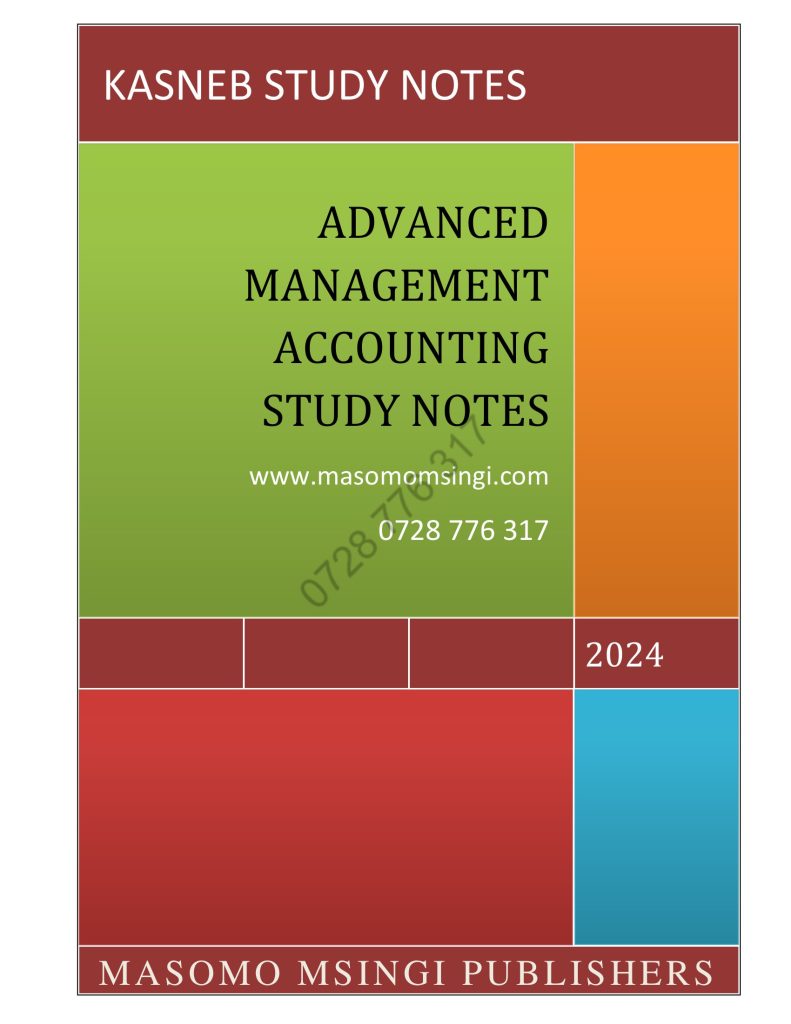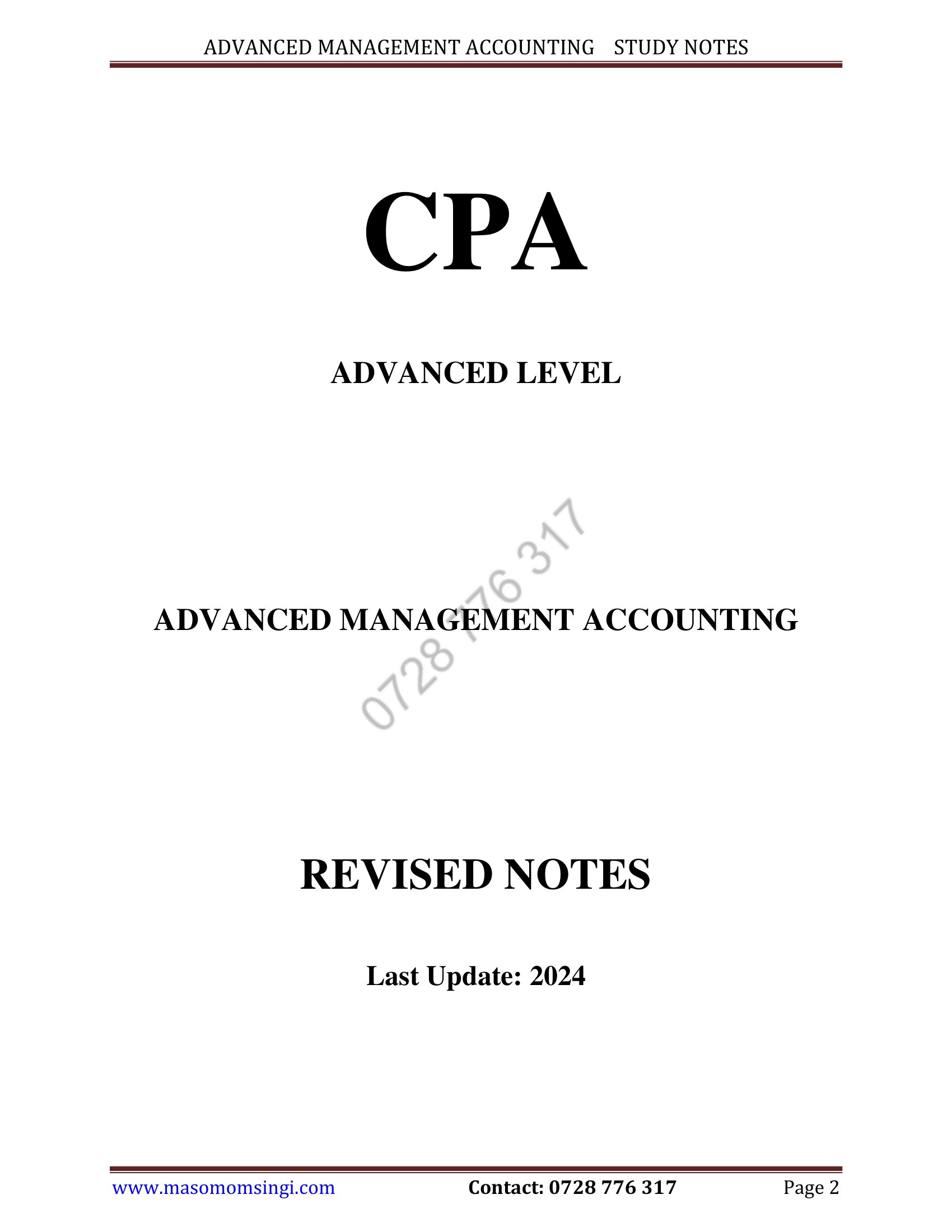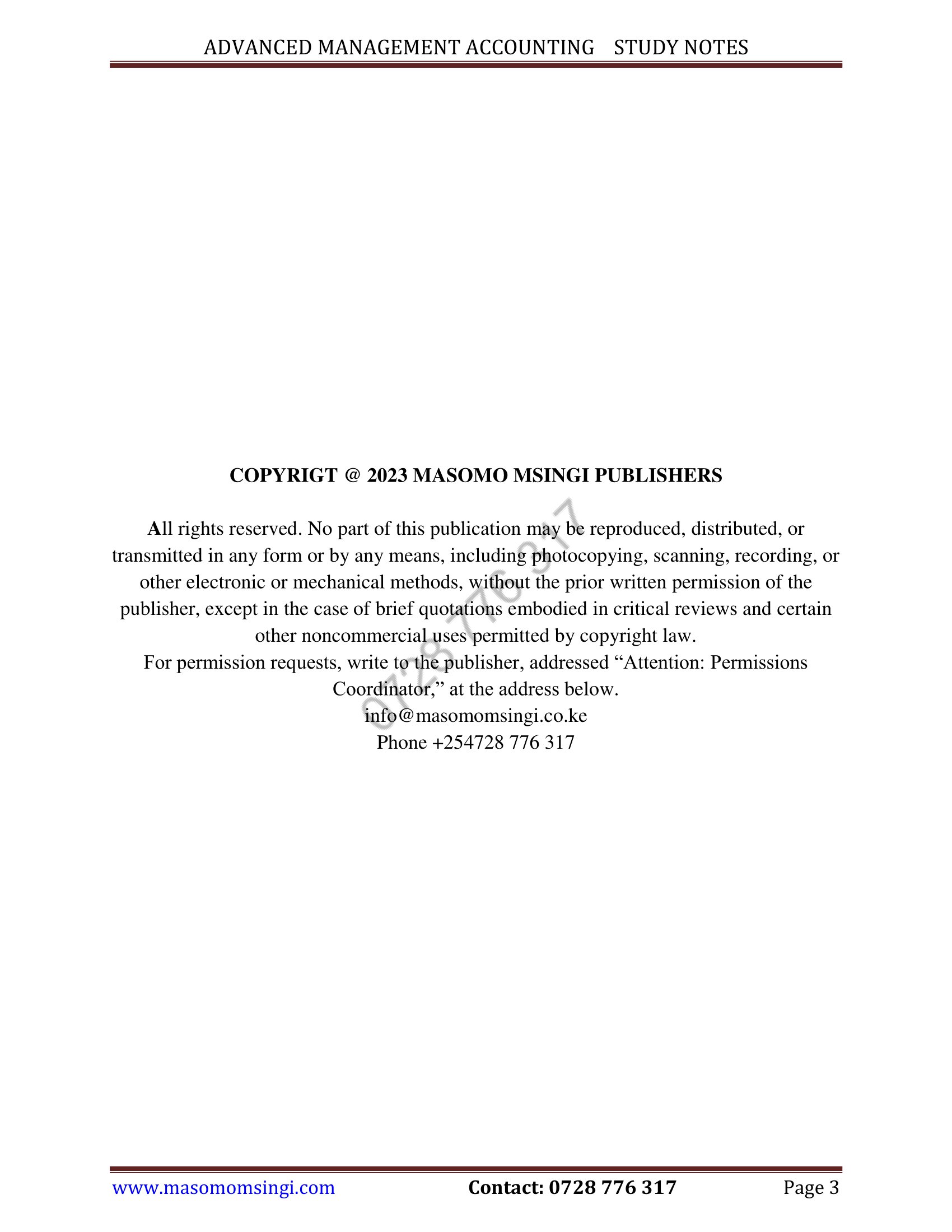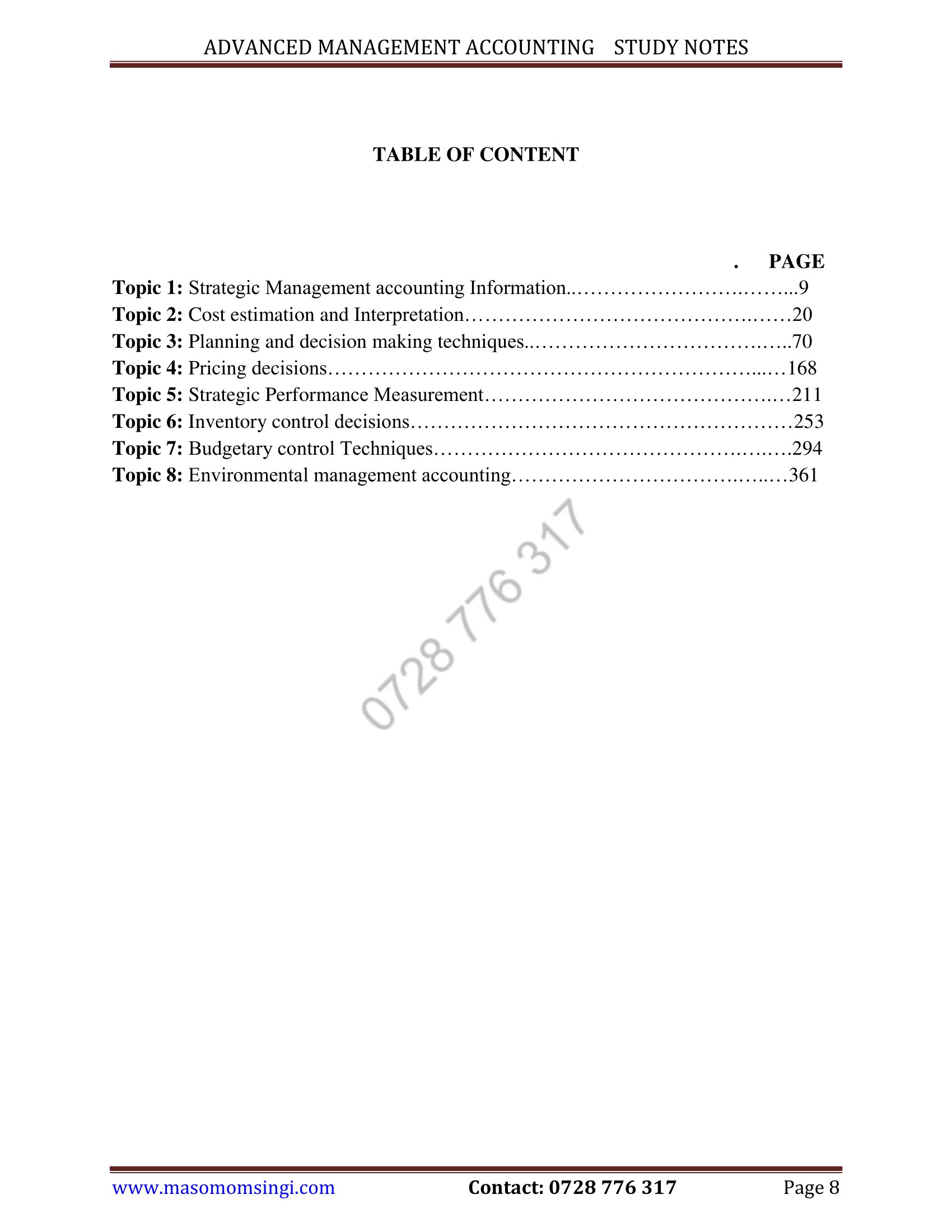


PAPER NO. 16 (S3) ADVANCED MANAGEMENT ACCOUNTING
UNIT DESCRIPTION
This paper is intended to equip the candidate with knowledge, skills and attitudes that will enable him/her to apply advanced management accounting tools and techniques for decision making in the context of organisational strategy.
LEARNING OUTCOMES
A candidate who passes this paper should be able to:
- Use cost estimation data in decision making
- Apply advanced management accounting techniques to aid in organisational strategic decision making
- Use financial and non-financial indicators to measure organisational performance
- Apply environmental management accounting concepts in practice.
CONTENT
- Strategic management accounting information
- Sources of strategic management accounting information
- Role of strategic management accounting in strategic planning and control
- Governance and control of strategic management accounting information
- Scope and limitations of management accounting
- Ethical standards for management accountants
- Cost estimation and interpretation
- Ordinary least square (OLS) method. Single and multiple predictors; tests of significance (goodness of fit, ANOVA/P-Value, economic plausibility tests, significance of independent variable/t-test)
- Specifications/assumptions of OLS (implications of serial correlation, multi- colinearity)
- Computer output and technical versus managerial interpretation of OLS results
- Learning curve models and their application
- Planning and decision making techniques
- Cost volume profit analysis (CVP) for single and multiple products under conditions of uncertainty
- Decision making under environments of uncertainty and risk, using conditional payoff tables and decision trees.
- Expected value of perfect information
- Relevant cost analysis
- Application of marginal costing (Non-routine decisions): Limiting factor analysis,
- Throughput accounting, make or buy decision, continue or discontinue/drop decisions, special order decisions and other short term decisions.
- Pricing decisions
- External pricing methods
- Transfer pricing in divisionalised companies: Domestic and international transfer pricing
- Product life cycle costing, Target costing and Kaizen costing
- Strategic performance measurement
- Functional and divisionalisedorganisational structures
- Responsibility accounting, responsibility centers and segmental reporting
- Divisional performance measures such as profit margin, asset turnover, return on investment(ROI), return on capital employed(ROCE), residual income(RI), accounting rate of return(ARR) and economic value added(EVA)
- Non-financial performance indicators
- Alternative performance measures such as balanced scorecard, performance pyramid, Fitzgerald and Moon’s building block model.
- Inventory control decisions
- Applications of certainty inventory models (EOQ and EBQ) in decision making
- Stochastic inventory models with and without stock out cost
- Marginal analysis for perishable stock items
- Application of simulation models in inventory control (with and without backorders)
- Application of strategic management decisions in inventory control: Just-in-time purchasing (JIT), ABC analysis and material requirement planning (MRP)
- Budgetary control techniques
- Applications of budgetary control systems: Top-down, bottom-up, rolling, zero- based(ZBB), activity-based (ABB), incremental, feedback and feed-forward controls.
- Use of operational variances in reconciling original budget with actual performance
- Advanced variance analysis, planning and operational analysis (Ex-post)
- Application of learning curve model and ABC in variance analysis
- Investigation models for variances.
- Environmental management accounting
- Role of accountants in managing and accounting for environmental cost
- Use of management accounting techniques in identification and allocation of environmental costs (Inflow/Outflow analysis, Flow cost accounting, Environmental lifecycle costing and Environmental Activity Based Costing).

SAMPLE WORK
Complete copy of CPA Advanced Management Accounting Study Text is available in SOFT copy (Reading using our MASOMO MSINGI PUBLISHERS APP) and in HARD copy
Phone: 0728 776 317
Email: info@masomomsingi.com
TOPIC 1
STRATEGIC MANAGEMENT ACCOUNTING INFORMATION
INTRODUCTION
Strategic management accounting is a form of management accounting which aims to provide information that is relevant to the process of strategic planning and control. The focus is on both external and internal information and nonfinancial as well as financial factors.
SOURCES OF MANAGEMENT ACCOUNTING INFORMATION
Internal Sources:
- Formal systems:
- Transaction data capture (sales, purchases, inventory, revenue)
- Financial accounting records (ledgers, cashbooks)
- Inventory control systems
- Payroll system
- Production department data (machine capacity, work in progress, maintenance)
- Time recording systems (e.g., for accountants and solicitors)
- Procurement data (purchase volumes, values)
- Marketing and sales data (sales history, forecasts, marketing campaign impact)
- Staff feedback (informally or through meetings, interviews, questionnaires)
- Informal sources:
- Day-to-day conversations and interactions between staff
- Observation and awareness of internal processes
External Sources:
- Formal collection:
- Tax law updates
- Legislation changes (health & safety, employment)
- R&D information
- Market research (customer opinions, buying attitudes)
- Informal gathering:
- Media
- Meetings with business associates
- Trade press
Specific External Sources:
- Associations: Industry-specific associations that publish data and insights for members.
- Government agencies: Provide economic data, industry and population trends, and other statistics.
- Other published sources: Digests, pocket books, periodicals, and online resources.
- Syndicated services: Market research data collected by research companies.
- Consumer panels: Continuous research monitoring buying activity of a representative sample of individuals.
- Customers: Feedback through satisfaction questionnaires, market research, comments, and complaints.
Benefits and limitations of external data
The benefits can be quantified in the following terms:
- The quality of decisions that the data has influenced
- Risk/uncertainties avoided by having the data
- The organisation’s ability to respond appropriately to the environment or to improve its performance
Limitations of external data
- One of the principal limitations of external data is that its quality cannot be guaranteed. Its quality will depend on the following characteristics
- The producers of the data. (How reliable are they? Are they neutral or might they be biased? For example, trade associations may not include data which runs counter to the interests of their members. In this respect, when looking at any external data an important consideration is the data’s completeness. Is it complete, or have the producers of the data been selective in what they report?)
- The reason for the data being collected in the first place. This might also affect the level of detail available in the data.
- The collection method. (Random samples with a poor response rate are particularly questionable.)
- The age of the data. Is it still current/relevant, or is it out of date now? (Government statistics and information based on them are often relatively dated, though information technology has speeded up the process.)
- How parameters were defined. (For instance, the definition of family used by some researchers could well be very different to that used by others.)
Advantages arising from the use of secondary (as opposed to primary) data
- The data may solve the problem without the need for any primary research: time and money is thereby saved.
- Cost savings can be substantial because secondary data sources are a great deal cheaper than those for primary research.
- Secondary data, while not necessarily fulfilling all the needs of the business, can be of great use in:
- Setting the parameters, defining a hypothesis, highlighting variables; in other words, helping to focus on the central problem
- Providing guidance, by showing past methods of research and so on, for primary data collection
- Helping to assimilate the primary research with past research, highlighting trends and the like
- Defining sampling parameters (target populations, variables and so on)
Disadvantages to the use of secondary data
- The data may not be relevant to the research objectives in terms of the data content itself, classifications used or units of measurement.
- Although secondary data is usually cheaper than primary data, some specialist reports can cost large amounts of money. A cost/benefit analysis will determine whether such secondary data should be used or whether primary research would be more economical.
- Secondary data may not exist in the specific product or market area.
- The secondary data may be biased, depending on who originally carried it out and for what purpose. Attempts should be made to obtain the most original source of the data, to assess it for such bias.
- The accuracy of the data should be questioned.
MASOMO MSINGI PUBLISHERS APP – Click to download and access all our materials in PDF
THE ROLE OF STRATEGIC MANAGEMENT ACCOUNTING IN STRATEGIC PLANNING AND CONTROL
An important point to note from the first section is the fact that managers need information to help them plan and control their businesses effectively. As such, management accounting information can be used for a variety of purposes.
- To measure performance. Management accounting information can be used to analyse the performance of an organisation as a whole, and/or of the individual divisions, departments or products within the business. Performance reports provide feedback, most frequently in the form of comparison between actual performance and
- To control the business. Performance reports are a crucial element in controlling a business. In order to be able to control their business, managers need to know the following:
(i) What they want the business to achieve (targets or standards; budgets)
(ii) What the business is actually achieving (actual performance)
By comparing the actual achievements with targeted performance, and identifying variances, management can decide whether corrective action is needed, and then take the necessary action when required.
Much control information is of an accounting nature because costs, revenues, profits and asset values are major factors in how well or how badly a business performs.
3. To plan for the future. Managers have to plan, and they need information to do this. Much of the information they use is management accounting information.
- To make decisions. Managers are faced with several types of decision.
Strategic decisions (which relate to the longer-term objectives of a business) require information which tends to relate to the organisation as a whole, is in summary form and is derived from both internal and external sources.
In addition, strategic decision making:
- Is medium to long term
- Involves high levels of uncertainty and risk (the future is unpredictable)
- Involves situations that may not recur
- Deals with complex issues
Tactical and operational decisions (which relate to the short or medium term and to a department, product or division rather than the organisation as a whole) require information which is more detailed and more restricted in its sources.
GOVERNANCE AND CONTROL OF STRATEGIC MANAGEMENT ACCOUNTING INFORMATION
Strategic Management Accounting (SMA) is a crucial tool for businesses to achieve their long-term goals. It provides information and analysis that helps managers make informed decisions about resource allocation, performance measurement, and risk management. However, the effectiveness of SMA relies heavily on governance and control mechanisms.
Here are some key points to consider:
Governance
- Board of Directors: responsible for overseeing the company’s strategy and ensuring that SMA is aligned with it.
- Management: responsible for implementing the company’s strategy and ensuring that SMA information is accurate, reliable, and timely.
- Internal Audit: responsible for independently assessing the effectiveness of the company’s SMA system.
- Compliance: ensuring that the company complies with all relevant laws and regulations governing SMA.
Control
- Access controls: restricting access to sensitive SMA information to authorized personnel only.
- Data security: protecting SMA information from unauthorized access, use, disclosure, disruption, modification, or destruction.
- Data quality: ensuring that SMA information is accurate, complete, and consistent.
- Process controls: monitoring and controlling the processes used to generate and use SMA information.
- Reporting and monitoring: regularly reporting on the effectiveness of the company’s SMA system and taking corrective action as needed.
Benefits of effective governance and control:
- Improved decision-making: SMA information can only be useful if it is reliable and trustworthy.
- Enhanced performance: Effective use of SMA can help companies achieve their strategic objectives.
- Reduced risk: Robust governance and control can help identify and mitigate risks associated with SMA.
- Increased stakeholder confidence: Good governance and control demonstrate that a company is committed to using SMA responsibly.
Challenges of governance and control:
- Cost: Implementing and maintaining effective governance and control can be expensive.
- Complexity: The evolving nature of business and technology can make it difficult to keep governance and control systems up to date.
- Lack of awareness: Not all stakeholders may be aware of the importance of governance and control for SMA.
Key Elements of Governance and Control of SMA Information
There are several key elements in the governance and control of SMA information, which are as follows:
- Responsible parties: Identifying the responsible parties for the governance and control of SMA information is crucial. This includes the board of directors, management, and internal and external auditors.
- Policies and procedures: Developing and implementing policies and procedures that outline the process for collecting, analyzing, and reporting SMA information is essential. This includes establishing standards for data collection, ensuring data quality, and defining roles and responsibilities.
- Reporting and communication: Regular reporting and communication of SMA information to relevant stakeholders is vital for effective decision-making. This includes providing timely and accurate information to top-level management, as well as ensuring that relevant information is communicated to employees and other stakeholders.
- Monitoring and evaluation: Continuous monitoring and evaluation of SMA information processes and controls are necessary to identify potential risks and ensure that the information remains accurate and relevant.
- Risk management: Identifying and managing risks associated with SMA information is crucial for maintaining the integrity of the data. This includes implementing appropriate controls to mitigate risks and ensuring that the organization is prepared to respond to potential issues.
CONTROLS
Controls need to be in place over the generation of internal information in routine and ad-hoc reports.
Controls over generating internal information in routine reports
- Carry out a cost-benefit analysis. How easy is the report to prepare compared with the usefulness of the decisions that can be taken as a result of its production? The cost of preparing the report will in part be determined by who is preparing it. The cost can be reduced if its preparation can be delegated by a director to a junior member of staff.
- A trial preparation process should be carried out and a prototype prepared. Users should be asked to confirm that their requirements will be met.
- A consistent format and consistent definitions should be used to ensure that reporting is accurate and the chance of misinterpretation is minimised. Standard house styles will ensure that time is not wasted by managers, staff and report writers on designing alternative layouts.
- The originator of the report should be clearly identified so that users’ queries can be dealt with quickly.
- The report should clearly set out limits to the action that users can take as a result of the information in the report. This will ensure that the organisation’s system of responsibilities is maintained.
- The usefulness of the report should be assessed on a periodic basis to ensure that its production is necessary.
Controls over generating internal information in ad hoc reports
- Carry out a cost-benefit analysis as above.
- Ensure that the required information does not already exist in another format.
- Brief the report writer so that only the relevant information is provided.
- Ensure that the originator is clearly identified.
- Ensure that report writers have access to the most up-to-date information.
SAMPLE WORK
Complete copy of CPA Advanced Management Accounting Study Text is available in SOFT copy (Reading using our MASOMO MSINGI PUBLISHERS APP) and in HARD copy
Phone: 0728 776 317
Email: info@masomomsingi.com
Controls over distributing internal information
A procedures manual sets out controls over distributing internal information.
(a) Procedures manual (for standard reports)
- Indicates what standard reports should be issued and when (eg budgetary control report for department X on a monthly basis)
- Sets out the format of standard reports
- Makes clear who should receive particular standard reports
- Indicates whether reports should be shredded (if confidential) or just binned
- Makes clear what information should be regarded as highly confidential
(b) Other controls
(i) Payroll and personnel information should be kept in a locked cabinet or be protected by password access on a computer system.
(ii) All employees should be contractually required not to divulge confidential information.
(iii) The internal mail system should make use of ‘private and confidential’ stamps.
(iv) An appropriate email policy should be set up.
- Email is best suited to short messages rather than detailed operational problems.
- Email provides a relatively permanent means of communication, which may be undesirable for confidential/’off-the-record’ exchanges.
- Staff may suffer from information overload.
- It is uncomfortable to read more than a full screen of information. Longer messages will either not be read properly or will be printed out (in which case they may just as well have been circulated in hard-copy form).
(v) Physical computer security
Internal security. Management can regulate which staff members have access to different types of data. For instance, access to HR records may be restricted to members of the HR team by keeping these records on a separate server or database. In this way, only certain terminals may access servers with sensitive or confidential data stored on them.
External security. The organisation can also protect its data from external access by using firewalls.
A firewall is designed to restrict access to a network by selectively allowing or blocking inbound traffic to parts of an organisation’s system. It examines messages entering and exiting the system and blocks any that do not conform to specified criteria. In this way, firewalls can be used to protect data and databases from being accessed by unauthorised people or terminals. For example, access to key servers could be restricted to a small number of terminals only.
A number of procedures can be used to ensure the security of highly confidential information that is not for external consumption:
- Passwords
- Logical access systems
- Database controls
- Firewalls
- Personnel security planning
- Anti-virus and anti-spyware software
SCOPE AND LIMITATIONS OF MANAGEMENT ACCOUNTING
SCOPE OF MANAGEMENT ACCOUNTING
This is very wide and includes various aspects of business activities.
- Financial Accounting
Financial Accounting is the foundation of Management Accounting as it provides the necessary information for informing detailed Management Accounting reports.
- Cost Accounting
Some the important tools of Cost Accounting such as standard costing, marginal costing, product pricing and budgetary control are applied while preparing management accounting reports.
- Statistical methods
Management Accounting is concerned with preparation of accounting information in the most impressive and understandable manner. It makes use of graphs, index numbers and other statistical analysis while preparing reports. For scientific analysis of Management Accounting statements, various statistical techniques and statistics such as mean, standard deviation, coefficient of correlation are used in Management Accounting.
- Taxation
Tax planning and its management is an essential function of the management. It includes computation of income, computation of tax, filing of tax etc.
LIMITATIONS OFMANAGEMENT ACCOUNTING
- It is based on accounting information
Management Accounting reports are based on accounting information, both internal and external sources, correctness and effectiveness of managerial decisions will depend on the quality an accuracy of the data on which the decisions are to be based.
If the data is not reliable, management accounting reports will not provide correct analysis of actual situation.
- Lack of knowledge on related subjects
The application of management accounting will be useful to management and related subject such as statistics, economics, calculus, principle of management, management information systems are needed.
In Management Accounting, decisions should be based on facts and figures but not past experience past decision.
- Management decisions are not alternative to administration
That is the tools and techniques of Management only provides information but not decisions.
Decisions should always be made by management after taking into consideration other factors.
- Evolutionary nature of Management Accounting
Management Accounting is only in its developmental stage. The techniques and tools used IT give different results and recommendations.
Functions of management accountant
- Collecting accurate, reliable and sufficient information for decision making.
- Designing accounting information system.
- Maintaining accounting records and preparation of financial estimates.
- Helps in preparation of budgets.
